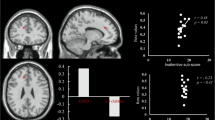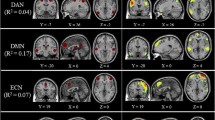Abstract
We examined the effect of a single dose of methylphenidate (MPH) on whole brain functional connectivity, assessed using resting state functional MRI (rsfMRI), in young people with ADHD. 16 young people with ADHD participated in two rsfMRI scans in a randomized, placebo-controlled study with an acute dose of MPH (20 mg). 15 typically developing controls also performed the task under placebo conditions. The network-based statistic (NBS) was used to identify differential connectivity patterns between the MPH and placebo conditions in the ADHD group. Mean connectivity of the resulting sub-network was examined in the ADHD and control groups. Resting state functional connectivity (RSFC) analysis revealed significantly reduced connectivity under MPH compared to placebo in young people with ADHD. Findings were robust across a range of thresholds. No sub-networks of increased connectivity were found at any threshold. Mean connectivity of the identified sub-network was significantly higher in ADHD individuals in the placebo condition compared to controls, however there was no difference between MPH condition and controls. We demonstrated a significant MPH-related reduction in RSFC in a large, robust network primarily involving occipital, temporal and cerebellar regions, and visual, executive and default mode networks. These findings suggest that MPH is ‘normalising’ a higher RSFC in young people with ADHD. This study is a novel addition to the understanding of treatment effects on the brain in ADHD.



Similar content being viewed by others
References
An, L., Cao, X.-H., Cao, Q.-J., Sun, L., Yang, L., Zou, Q.-H., et al. (2013). Methylphenidate normalizes resting-state brain dysfunction in boys with attention deficit hyperactivity disorder. Neuropsychopharmacology: official publication of the American College of Neuropsychopharmacology, 38(7), 1287–1295. doi:10.1038/npp.2013.27.
Behzadi, Y., Restom, K., Liau, J., & Liu, T. T. (2007). A component based noise correction method (CompCor) for BOLD and perfusion based fMRI. NeuroImage, 37(1), 90–101. doi:10.1016/j.neuroimage.2007.04.042.
Bond, A., & Lader, M. (1974). The use of analogue scales in rating subjective feelings. British Journal of Medical Psychology, 47(3), 211–218. doi:10.1111/j.2044-8341.1974.tb02285.x.
Buckner, R. L., Andrews Hanna, J. R., & Schacter, D. L. (2008). The Brain’s default network. Annals of the New York Academy of Sciences, 1124(1), 1–38. doi:10.1196/annals.1440.011.
Cao, M., Shu, N., Cao, Q., Wang, Y., & He, Y. (2014). Imaging functional and structural brain connectomics in attention-deficit/hyperactivity disorder. Molecular Neurobiology, 50(3), 1111–1123. doi:10.1007/s12035-014-8685-x.
Castellanos, F. X., & Proal, E. (2012). Large-scale brain systems in ADHD: beyond the prefrontal-striatal model. Trends in Cognitive Sciences, 16(1), 17–26. doi:10.1016/j.tics.2011.11.007.
Cohen, J. (1988). Statistical power analysis for the behavioral sciences. New York, NY: Routledge Academic
Czerniak, S. M., Sikoglu, E. M., King, J. A., Kennedy, D. N., Mick, E., Frazier, J., & Moore, C. M. (2013). Areas of the brain modulated by single-dose methylphenidate treatment in youth with ADHD during task-based fMRI: a systematic review. Harvard Review of Psychiatry, 21(3), 151–162. doi:10.1097/HRP.0b013e318293749e.
Dwyer, D. B., Harrison, B. J., Yuecel, M., Whittle, S., Zalesky, A., Pantelis, C., et al. (2014). Large-scale brain network dynamics supporting adolescent cognitive control. Journal of Neuroscience, 34(42), 14096–14107. doi:10.1523/JNEUROSCI.1634-14.2014.
Eichele, T., Debener, S., Calhoun, V. D., Specht, K., Engel, A. K., Hugdahl, K., et al. (2008). Prediction of human errors by maladaptive changes in event-related brain networks. Proceedings of the National Academy of Sciences of the United States of America, 105(16), 6173–6178. doi:10.1073/pnas.0708965105.
Farr, O. M., Zhang, S., Hu, S., Matuskey, D., Abdelghany, O., Malison, R. T., & Li, C.-S. R. (2014). The effects of methylphenidate on resting-state striatal, thalamic and global functional connectivity in healthy adults. International Journal of Neuropsychopharmacology, 17(8), 1177–1191. doi:10.1017/S1461145714000674.
Fornito, A., Harrison, B. J., Zalesky, A., & Simons, J. S. (2012). Competitive and cooperative dynamics of large-scale brain functional networks supporting recollection. Proceedings of the National Academy of Sciences of the United States of America, 109(31), 12788–12793. doi:10.1073/pnas.1204185109.
Friston, K. J., Jezzard, P., & Turner, R. (1994). Analysis of functional MRI time-series. Human Brain Mapping, 1(2), 153–171. doi:10.1002/hbm.460010207.
Goetz, M., Vesela, M., & Ptacek, R. (2014). Notes on the role of the cerebellum in ADHD.
Hedges, L. V. (1981). Distribution theory for Glass’s estimator of effect size and related estimators. Journal of Educational and Behavioral Statistics, 6(2), 107–128. doi:10.3102/10769986006002107.
Hotelling, H. (1953). New light on the correlation coefficient and its transforms. Journal of the Royal Statistical Society, Series B. doi:10.2307/2983768.
Kimko, H. C., Cross, J. T., & Abernethy, D. R. (1999). Pharmacokinetics and clinical effectiveness of methylphenidate. Clinical Pharmacokinetics, 37(6), 457–470. doi:10.2165/00003088-199937060-00002.
Koziol, L. F., Budding, D., Andreasen, N., D’Arrigo, S., Bulgheroni, S., Imamizu, H., et al. (2014). Consensus paper: the cerebellum’s role in movement and cognition. In Presented at the Cerebellum (Vol. 13, pp. 151–177). London: Springer. doi:10.1007/s12311-013-0511-x.
Lee, J. S., Kim, B. N., Kang, E., Lee, D. S., Kim, Y. K., Chung, J. K., et al. (2005). Regional cerebral blood flow in children with attention deficit hyperactivity disorder: comparison before and after methylphenidate treatment. Human Brain Mapping, 24(3), 157–164. doi:10.1002/hbm.20067.
Li, S. J., Biswal, B., Li, Z., Risinger, R., Rainey, C., Cho, J. K., et al. (2000). Cocaine administration decreases functional connectivity in human primary visual and motor cortex as detected by functional MRI. Magnetic Resonance in Medicine, 43(1), 45–51.
Liddle, E. B., Hollis, C., Batty, M. J., Groom, M. J., Totman, J. J., Liotti, M., et al. (2011). Task-related default mode network modulation and inhibitory control in ADHD: effects of motivation and methylphenidate. Journal of Child Psychology and Psychiatry, and Allied Disciplines, 52(7), 761–771. doi:10.1111/j.1469-7610.2010.02333.x.
Makris, N., Goldstein, J. M., Kennedy, D., Hodge, S. M., Caviness, V. S., Faraone, S. V., et al. (2006). Decreased volume of left and total anterior insular lobule in schizophrenia. Schizophrenia Research, 83(2–3), 155–171. doi:10.1016/j.schres.2005.11.020.
Mueller, S., Costa, A., Keeser, D., Pogarell, O., Berman, A., Coates, U., et al. (2014). The effects of methylphenidate on whole brain intrinsic functional connectivity. Human Brain Mapping, 35(11), 5379–5388. doi:10.1002/hbm.22557.
O’Gorman, R. L., Mehta, M. A., Asherson, P., Zelaya, F. O., Brookes, K. J., Toone, B. K., et al. (2008). Increased cerebral perfusion in adult attention deficit hyperactivity disorder is normalised by stimulant treatment: a non-invasive MRI pilot study. NeuroImage, 42(1), 36–41. doi:10.1016/j.neuroimage.2008.04.169.
Peterson, B. S., Marc, N., Potenza, M. D. P. D., Zhishun Wang, P. D., Hongtu Zhu, P. D., Andrés Martin, M. D., Rachel Marsh, P. D., et al. (2009). An fMRI study of the effects of psychostimulants on default-mode processing during Stroop task performance in youths with ADHD. American Journal of Psychiatry, 166(11), 1286–1294. doi:10.1176/appi.ajp.2009.08050724.
Posner, J., Park, C., & Wang, Z. (2014). Connecting the dots: a review of resting connectivity MRI studies in attention-deficit/hyperactivity disorder. Neuropsychology Review, 24(1), 3–15. doi:10.1007/s11065-014-9251-z.
Power, J. D., Barnes, K. A., Snyder, A. Z., Schlaggar, B. L., & Petersen, S. E. (2012). Spurious but systematic correlations in functional connectivity MRI networks arise from subject motion. NeuroImage, 59(3), 2142–2154. doi:10.1016/j.neuroimage.2011.10.018.
Raichle, M. E., & Snyder, A. Z. (2007). A default mode of brain function: a brief history of an evolving idea. NeuroImage, 37(4), 1083–1090 discussion 1097–9. doi:10.1016/j.neuroimage.2007.02.041.
Ricciardi, E., Handjaras, G., Bernardi, G., Pietrini, P., & Furey, M. L. (2013). Cholinergic enhancement reduces functional connectivity and BOLD variability in visual extrastriate cortex during selective attention. Neuropharmacology, 64, 305–313. doi:10.1016/j.neuropharm.2012.07.003.
Rubia, K., Alegría, A. A., Cubillo, A. I., Smith, A. B., Brammer, M. J., & Radua, J. (2014). Effects of stimulants on brain function in attention-deficit/hyperactivity disorder: a systematic review and meta-analysis. Biological Psychiatry, 76(8), 616–628. doi:10.1016/j.biopsych.2013.10.016.
Schmahmann, J. D., Weilburg, J. B., & Sherman, J. C. (2007). The neuropsychiatry of the cerebellum - insights from the clinic. Cerebellum (London, England), 6(3), 254–267. doi:10.1080/14734220701490995.
Schweitzer, J. B., Lee, D. O., Hanford, R. B., Tagamets, M. A., Hoffman, J. M., Grafton, S. T., & Kilts, C. D. (2003). A positron emission tomography study of methylphenidate in adults with ADHD: alterations in resting blood flow and predicting treatment response. Neuropsychopharmacology: official publication of the American College of Neuropsychopharmacology, 28(5), 967–973. doi:10.1038/sj.npp.1300110.
Smith, S. M., Fox, P. T., Miller, K. L., Glahn, D. C., Fox, P. M., Mackay, C. E., et al. (2009). Correspondence of the brain’s functional architecture during activation and rest. Proceedings of the National Academy of Sciences of the United States of America, 106(31), 13040–13045. doi:10.1073/pnas.0905267106.
Sonuga-Barke, E. J. S., & Castellanos, F. X. (2007). Spontaneous attentional fluctuations in impaired states and pathological conditions: a neurobiological hypothesis. Neuroscience and Biobehavioral Reviews, 31(7), 977–986. doi:10.1016/j.neubiorev.2007.02.005.
Spencer, T. J., Brown, A., Seidman, L. J., Valera, E. M., Makris, N., Lomedico, A., et al. (2013). Effect of psychostimulants on brain structure and function in ADHD: a qualitative literature review of magnetic resonance imaging-based neuroimaging studies. The Journal of Clinical Psychiatry, 74(9), 902–917. doi:10.4088/JCP.12r08287.
Sripada, C. S., Kessler, D., Welsh, R., Angstadt, M., Liberzon, I., Phan, K. L., & Scott, C. (2013). Distributed effects of methylphenidate on the network structure of the resting brain: a connectomic pattern classification analysis. NeuroImage, 81, 213–221. doi:10.1016/j.neuroimage.2013.05.016.
Tomasi, D., Volkow, N. D., Wang, G. J., Wang, R., Telang, F., Caparelli, E. C., et al. (2011). Methylphenidate enhances brain activation and deactivation responses to visual attention and working memory tasks in healthy controls. NeuroImage, 54(4), 3101–3110. doi:10.1016/j.neuroimage.2010.10.060.
Tzourio-Mazoyer, N., Landeau, B., Papathanassiou, D., Crivello, F., Etard, O., Delcroix, N., et al. (2002). Automated anatomical labeling of activations in SPM using a macroscopic anatomical parcellation of the MNI MRI single-subject brain. NeuroImage, 15(1), 273–289. doi:10.1006/nimg.2001.0978.
Valera, E. M., Faraone, S. V., Murray, K. E., & Seidman, L. J. (2007). Meta-analysis of structural imaging findings in attention-deficit/hyperactivity disorder. Biological Psychiatry, 61(12), 1361–1369. doi:10.1016/j.biopsych.2006.06.011.
Van Dijk, K. R. A., Sabuncu, M. R., & Buckner, R. L. (2012). The influence of head motion on intrinsic functional connectivity MRI. NeuroImage, 59(1), 431–438. doi:10.1016/j.neuroimage.2011.07.044.
Weissman, D. H., Roberts, K. C., & Visscher, K. M. (2006). The neural bases of momentary lapses in attention. Nature Neuroscience, 9, 971–978.
Whitfield-Gabrieli, S., & Nieto-Castanon, A. (2012). Conn: a functional connectivity toolbox for correlated and anticorrelated brain networks. Brain Connectivity, 2(3), 125–141. doi:10.1089/brain.2012.0073.
Xia, M., Wang, J., & He, Y. (2013). BrainNet viewer: a network visualization tool for human brain connectomics. PloS One, 8(7), e68910. doi:10.1371/journal.pone.0068910.
Zalesky, A., Fornito, A., & Bullmore, E. T. (2010). Network-based statistic: identifying differences in brain networks. NeuroImage, 53(4), 1197–1207. doi:10.1016/j.neuroimage.2010.06.041.
Acknowledgments
This work was supported by a Project Grant to MAB and AV (No. 569533) from the National Health and Medical Research Council of Australia. TS was supported by a NHMRC Career Development Award. The research was conducted within the Academic Child Psychiatry Unit, University of Melbourne, Royal Children’s Hospital and the Developmental Imaging research group, Murdoch Childrens Research Institute (MCRI) and the Children’s MRI Centre, Royal Children’s Hospital, Melbourne, Victoria. It was also supported by The Royal Children’s Hospital Foundation and the Victorian Government’s Operational Infrastructure Support Program. This trial was registered at Australian New Zealand Clinical Trials Registry (www.anzctr.org.au) as ACTRN12610000652077. We thank Alex Fornito for his feedback on the manuscript.
Author information
Authors and Affiliations
Corresponding author
Ethics declarations
Funding
This work was supported by a Project Grant to MAB and AV (No. 569,533) from the National Health and Medical Research Council of Australia.
Conflict of interest
The authors declare that they have no conflict of interest.
Ethical approval
All procedures performed in studies involving human participants were in accordance with the ethical standards of the institutional and/or national research committee and with the 1964 Helsinki declaration and its later amendments or comparable ethical standards.
Informed consent
Informed consent was obtained from all individual participants included in the study.
Electronic supplementary material
ESM 1
(DOCX 179 kb)
Rights and permissions
About this article
Cite this article
Silk, T.J., Malpas, C., Vance, A. et al. The effect of single-dose methylphenidate on resting-state network functional connectivity in ADHD. Brain Imaging and Behavior 11, 1422–1431 (2017). https://doi.org/10.1007/s11682-016-9620-8
Published:
Issue Date:
DOI: https://doi.org/10.1007/s11682-016-9620-8




